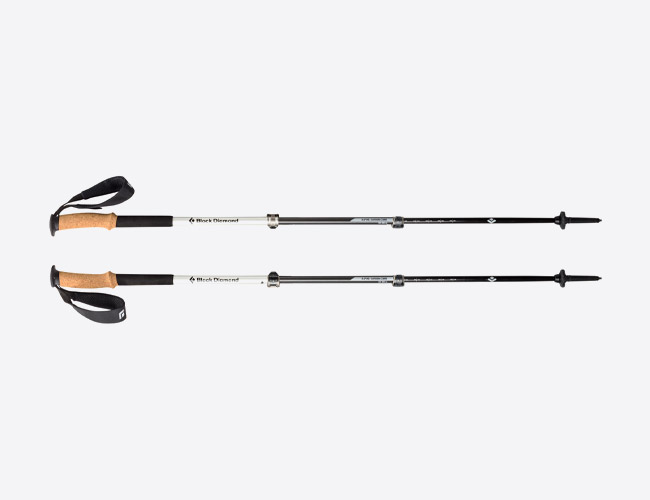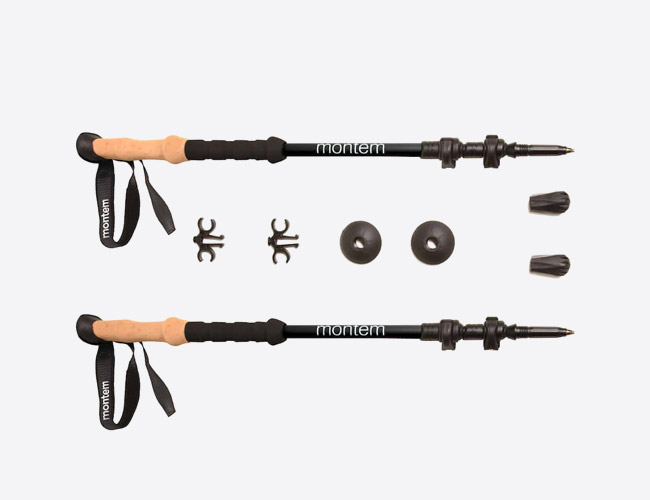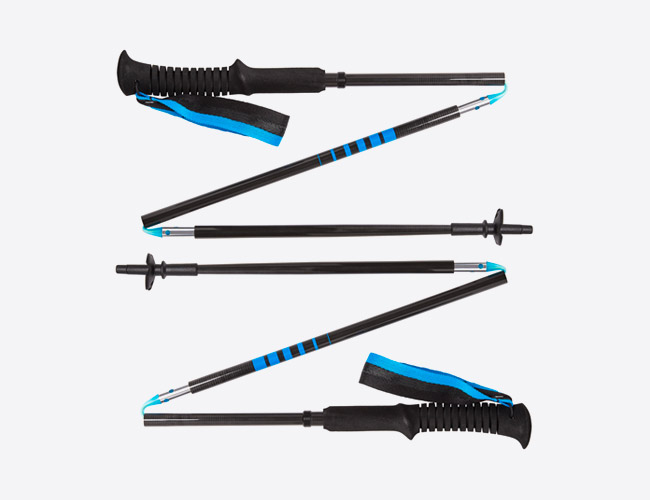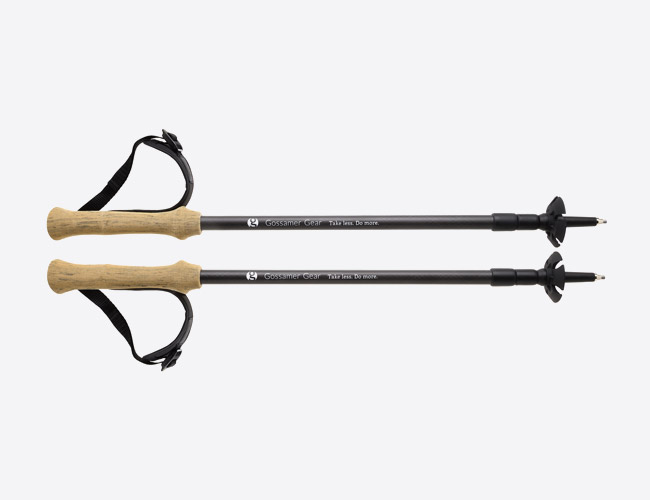If you’ve never used a pair of trekking poles for hiking, you’re in for a treat. They’re useful for so many things: They help improve your balance when you’re picking your way along rough or unstable ground, stepping through a fast-moving stream, or pushing yourself up a steep hill. They keep you steady when you’re carrying a heavy pack and your stability isn’t as good as usual. They also reduce joint impact, absorbing the shock on the lower half of your body, especially on downhills. (A study by the Steadman-Hawkins Sports Medicine Foundation found that poles absorb up to 4.4 percent of the force that would usually reverberate through your whole body while walking.) And trekking poles also bring your upper body into your workout, increasing cardiac benefits.
Whether you’re an experienced thru-hiker, a newbie to the trail or an outdoors lover who’s worried about joint damage, this guide is for you. To save you time, we cut straight to the chase with reviews of the best poles money can buy. But should that roundup not fully slake your thirst for knowledge, keep reading for more details on when and how to use trekking poles, finding the ideal trekking pole for you, and more.
How We Tested
We spent about 10 hours researching trekking poles for this guide. We looked at poles that ranged in price from $20 to $200 and read dozens of customer and media reviews of the newest trekking poles on the market. We also spoke with several experts to get their perspectives on the ideal features and use cases for trekking poles.
Next, we ordered a pile of trekking poles to test out on the trail. We took them on several hikes in the Pacific Northwest mountains, weathering nearly 20 miles of rain, mud, sun, wind and dirt. We experimented with each set of poles on uphills and downhills. We used them to help us balance across stream crossings and boulder fields while wearing heavy packs. We also took notes about how easy the poles were to adjust, and how lightweight and packable they were. In the end, we anointed these four pairs as the best trekking poles money can buy right now.
The Best All-Around Trekking Poles: Black Diamond Alpine Carbon Cork Trekking Poles
If you’re only planning to buy one pair of trekking poles for all your adventures, make it the Black Diamond Alpine Carbon Cork Trekking Poles. At $153, they’re pricey, but after several hikes, we felt the cost was justified. These carbon-fiber shaft poles are lightweight (together, they weigh about one pound) yet durable. The cork handles have a non-slip EVA foam-grip extension that acts as a useful handle for downhills. Once tightened (which took us some fiddling), a set of dual-click locks keeps these telescoping poles in place no matter how much weight you put on them. Both our tallest and shortest testers loved these poles, which can extend from 25 to 51 inches—and pack down to 25 inches when not in use.
During testing, we liked that they didn’t vibrate (some poles wobble) on uphills or downhills. They provided good traction in muddy spots or where rocks were loose, and we came home with happy knees and ankles. After spending nearly eight miles with these poles, we wanted to reach for them first over and over again, no questions asked.
The Best Trekking Poles for Hikers on a Budget: Montem Ultra Strong Trekking Poles
Montem’s Ultra Strong Trekking Poles were the least expensive poles we tried, and we believe they’re an excellent choice for people who plan to use poles on occasion and aren’t concerned with weight (they’re aluminum). They clock in at 9.6 ounces per pole, which can add up as the miles do; our arms tired more quickly with these poles than with the others here. On the upside, the Ultra Strong’s foam grips felt relatively comfortable in our hands. These poles can extend from 24 to 53 inches, making them ideal for people of all heights, even those taller than six feet. These poles also come with baskets (for winter adventures), clips (to keep them together in your pack), and plastic caps (to cover tips on muddy days).
The Ultra Strong poles telescope down to 24 inches, so they can be strapped to the side of your pack for easy access. We noticed that when our 6’3″ tester leaned heavily on the poles, the locking mechanisms loosened over time, and one pole shortened a bit. We recommended tightening up the locks beforehand and going for a more heavy-duty option if you expect to put significant weight on your poles.
Most Packable Trekking Poles: Black Diamond Carbon Z Trekking Poles
If you’re looking for a travel-friendly option, the Black Diamond Distance Carbon Z is your best bet. They’re lightweight, made with carbon fiber and weigh just about one pound combined. Because these poles fold (rather than telescope), you do have to order the proper length for your height; options include 100 cm, 110 cm, 120 cm and 130 cm, and there’s a sizing chart at the link below. When you’re not using them, the Carbon Zs can be collapsed down to 13- to 17-inches, depending on the size you choose.
We particularly liked how light and nimble these poles felt on the trail. That said, the Carbon Z’s tips can sometimes get stuck in the mud, which pulls the tent-pole-like shafts out of their sockets and makes them wobbly. To prevent this inconvenience, keep the plastic covers on the pole tips (which is better for the environment anyway, although it does reduce traction a bit).
Best Ultra-lite Trekking Poles: Gossamer Gear LT5 Three Piece Carbon Trekking Poles
If you’re going to spend $200 on trekking poles, it had better be worth it. The Gossamer Gear LT5s are incredibly lightweight, weighing only 5.3 ounces per pole, and they offer a good range of heights, from 23.5 to 51 inches. They pack down quite small, to just 23.5 inches, and they’re so minimalistic that you barely notice you’re carrying anything when they’re stowed.
After several hikes, we found these telescoping poles were the easiest to adjust. (They had a twisting system rather than a snap lock, which, it’s worth noting, may be less durable.) We also loved the adjustable wrist sling for keeping our hands in place and letting us keep a loose grip on the poles. If you’re concerned about weight or want a pair of luxury poles, the Gossamer LT5 poles are a no-brainer.
When To Use Trekking Poles
“When I was planning my thru-hike of the Appalachian trail, I only knew one person who had thru-hiked before,” says Laura Evenson, sales lead at REI and experienced thru-hiker. “Their one piece of advice was to buy trekking poles, so I did. But I carried them in my pack for the first few days without using them. Then someone told me to try them for a week and ship them home if I didn’t like them.” Evenson never shipped them because they helped her on uphills and downhills, making ascents and descents easier for her. If you’re headed out for a day hike on a relatively flat, groomed trail, you may want to leave your hiking poles at home, but for anything longer, they can be useful.
Researchers from the Steadman-Hawkins Sports Medicine Foundation found that using trekking poles improves your posture; this added stability is especially crucial for spinal health and managing back pain on uneven, debilitating terrain. You’ll want trekking poles if you’re on a trail with massive uphills and downhills. Poles can help to increase your power when you’re walking uphill, and they also increase your speed on the downhill because you don’t have to worry as much about being sure-footed. Rivers, streams, loose rocks or debris (maybe even ice or snow): Bring ’em.
What To Look For In A Good Pair of Trekking Poles
Good trekking poles are lightweight, durable, easily packable and adjustable. They should telescope, which means they disappear into themselves, or fold up, for easy stashing and transport.
One critical element to think about is the handle. “Find a handle you like,” says Evenson of the cork, foam and rubber options out there. There isn’t much science to it beyond personal preference, although rubber can be more prone to causing blisters and weighs more.
Another feature to consider is the locking mechanism. Twist locks and level locks both do the job, but the former tend to break down more quickly.
Lastly, lighter is generally better. The heavier your poles, the more fatigued your arms will be after a long day on the trail. Opt for carbon fiber if weight is your top priority — they’re lighter than aluminum (the other most common material), though less durable and, yes, more expensive.
How To Use Trekking Poles
You’ll want to carry a pole in each hand, for the best balance, cadence and aid to your joints. Using just one pole can overstress one side of the body, Evenson notes.
If your pole has a wrist loop, use it. It’s meant to reduce the likelihood of blisters and hand fatigue because you won’t need to grip the pole as tightly.
As you walk, place the pole on the ground several inches ahead of your feet, moving the poles forward in a rotating fashion as you walk. Use the poles to stabilize your body as you move, working to bring them into your hiking cadence.
What Height Should I Buy?
When holding your trekking poles’ handles, your elbows should be at a 90-degree angle from your body and your forearms should be parallel to the ground. The good news is most trekking poles are adjustable.
Some hikers will adjust their poles for extended uphills and downhills, Evenson says, noting that it’s easier to use shorter poles on the uphills and longer poles on the downhills. That’s not fully necessary, though: “I just hold them on the top of the handle on my way down, for extra length,” she says.
If you’re between 5’1″ and 5’11”, 110- and 120-cm poles (43-47 inches) will be just right. Someone shorter than 5’1″ will want poles that are about 100 cm (39 inches), and someone taller than six feet may want to order extra long poles that extend to or beyond 130 cm (51 inches).
How Much Should I Spend?
Trekking poles can cost anywhere from $20 to $200. Spend at least $60; anything less and they’ll break after a few uses. The sweet spot is $150, which typically means carbon fiber, lightweight, packable, easily adjustable and durable.
Do I Need Trekking Poles That Fold?
Packable trekking poles are essential because you may not always need your poles during a hike, and you’ll want to be able to easily store them in your pack, your car or your garage — and in your luggage when you travel. A folding set of poles will break down to a slightly smaller size than telescoping poles, making them more packable.








